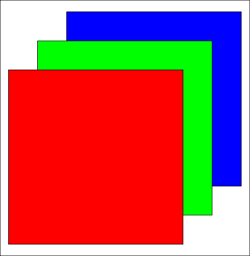Color image
A (digital) color image is a digital image that includes color information for each pixel.
For visually acceptable results, it is necessary (and almost sufficient) to provide three samples (color channels) for each pixel, which are interpreted as coordinates in some color space. The RGB color space is commonly used in computer displays, but other spaces such as YCbCr, HSV, and are often used in other contexts.A color image has three values per pixel and they measure the intensity and chrominance of light. The actual information stored in the digital image data is the brightness information in each spectral band.
Color image representation
A color image is usually stored in memory as a raster map, a two-dimensional array of small integer triplets; or (rarely) as three separate raster maps, one for each channel.

Eight bits per sample (24 bits per pixel) seem adequate for most uses, but faint banding artifacts may still be visible in some smoothly varying images, especially those subject to processing. Particularly demanding applications may use 10 bits per sample or more.
On the other hand, some widely used image file formats and graphics cards may use only 8 bits per pixel, i.e., only 256 different colors, or 2–3 bits per channel. Converting continuous-tone images like photographs to such formats requires dithering and yields rather grainy and fuzzy results.
Graphics cards that support 16 bits per pixel provide 65536 distinct colors, or 5–6 bits per channel. This resolution seems satisfactory for non-professional uses, even without dithering.
| ||||||||||||||||||||||||||||||||||||||||||||||||||||||||||||||||